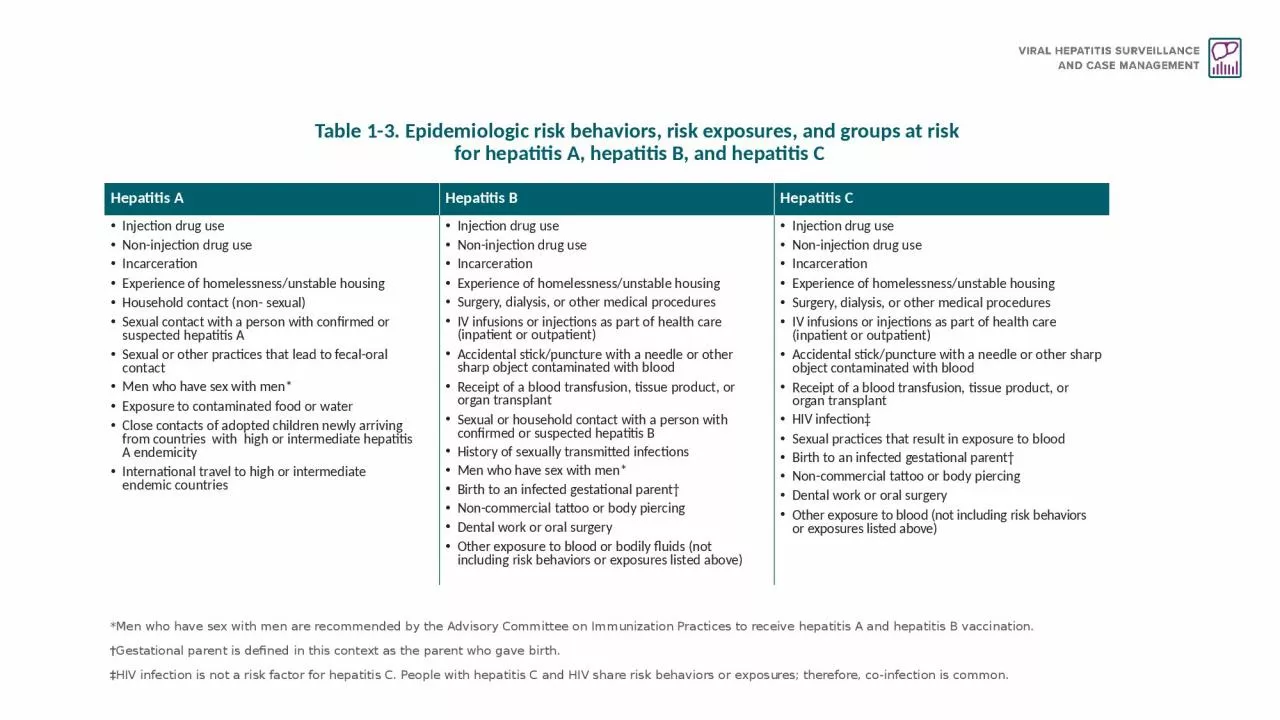

for hepatitis A hepatitis B and hepatitis C Hepatitis A Hepatitis B Hepatitis C Injection drug use Noninjection drug use Incarceration Experience of homelessness unstable ID: 927445
Download Presentation The PPT/PDF document "Table 1-3. Epidemiologic risk behaviors,..." is the property of its rightful owner. Permission is granted to download and print the materials on this web site for personal, non-commercial use only, and to display it on your personal computer provided you do not modify the materials and that you retain all copyright notices contained in the materials. By downloading content from our website, you accept the terms of this agreement.
Slide1
Table 1-3. Epidemiologic risk behaviors, risk exposures, and groups at risk
for hepatitis A, hepatitis B, and hepatitis C
Hepatitis AHepatitis BHepatitis CInjection drug useNon-injection drug useIncarcerationExperience of homelessness/unstable housingHousehold contact (non- sexual)Sexual contact with a person with confirmed or suspected hepatitis ASexual or other practices that lead to fecal-oral contactMen who have sex with men*Exposure to contaminated food or waterClose contacts of adopted children newly arriving from countries with high or intermediate hepatitis A endemicityInternational travel to high or intermediate endemic countriesInjection drug useNon-injection drug useIncarcerationExperience of homelessness/unstable housingSurgery, dialysis, or other medical proceduresIV infusions or injections as part of health care (inpatient or outpatient)Accidental stick/puncture with a needle or other sharp object contaminated with bloodReceipt of a blood transfusion, tissue product, or organ transplantSexual or household contact with a person with confirmed or suspected hepatitis BHistory of sexually transmitted infectionsMen who have sex with men*Birth to an infected gestational parent†Non-commercial tattoo or body piercingDental work or oral surgeryOther exposure to blood or bodily fluids (not including risk behaviors or exposures listed above)Injection drug useNon-injection drug useIncarcerationExperience of homelessness/unstable housingSurgery, dialysis, or other medical proceduresIV infusions or injections as part of health care (inpatient or outpatient)Accidental stick/puncture with a needle or other sharp object contaminated with bloodReceipt of a blood transfusion, tissue product, or organ transplantHIV infection‡Sexual practices that result in exposure to bloodBirth to an infected gestational parent†Non-commercial tattoo or body piercingDental work or oral surgeryOther exposure to blood (not including risk behaviors or exposures listed above)
*Men
who have
sex
with
men are
recommended by
the
Advisory
Committee on
Immunization Practices
to receive
hepatitis A
and hepatitis
B vaccination.
†Gestational
parent
is
defined
in
this
context
as
the
parent
who
gave
birth.
‡HIV
infection is not a risk factor for hepatitis
C.
People
with hepatitis C and HIV share risk behaviors or
exposures;
therefore,
co-infection is common.